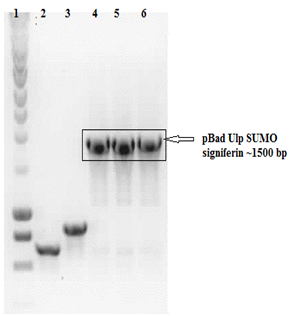Part:BBa_K1022117
pBAD: Ulp: TT: pT7: RBS: His6- SUMO: Signiferin
This biobrick codes for the promoter pBAD and Ulp protease with Double terminator followed by promoter pT7 and His 6 SUMO tagged Signiferin peptide.
Sequence and Features
- 10COMPATIBLE WITH RFC[10]
- 12INCOMPATIBLE WITH RFC[12]Illegal NheI site found at 18
Illegal NheI site found at 938
Illegal NotI site found at 714 - 21INCOMPATIBLE WITH RFC[21]Illegal BglII site found at 1062
Illegal BamHI site found at 683
Illegal XhoI site found at 692
Illegal XhoI site found at 723 - 23COMPATIBLE WITH RFC[23]
- 25INCOMPATIBLE WITH RFC[25]Illegal AgeI site found at 1247
- 1000COMPATIBLE WITH RFC[1000]
Characterization
For more info, visit [http://2013.igem.org/Team:TU-Delft/Peptides#cleavage TU Delft iGEM13 Wiki]
Cleavage of SUMO from Peptide by Ulp-1 protease
Introduction:
The SUMO-peptide helps in increasing the soluble fraction of peptide but peptides are not biologically active in a fusion, they have to be cleaved from the fusion to get a active peptide fraction. This was achieved by in vivo production on SUMO specific Ulp-1 proteases.
The biobrick BBa_K1022117 was constructed in such a way that the SUMO-peptide production was driven by the strong T7 phage promoter and the Ulp-1 production was driven by arabinose inducible promoter pBad. The plasmid was transformed into an BL21(DE3) pLysS strain. This construct was designed to check whether in vivo cleavage is possible. The main idea of the experiment is to first produce large amount of soluble fraction of SUMO-peptides and the produce the Ulp protease to cleave the sufficiently produced fusion peptides.
The protocol can be seen [http://2013.igem.org/Team:TU-Delft/Protocol_11#protocol_11 here].
Result:
The presence of plasmid with gene inserts encoding the SUMO-peptide (BBa_K1022116/117/118) was confirmed by a colony pcr. The expected size of the insert was approximately around ~1500 bp which was clearly evident from the agarose gel picture figure below. Though the actual size of the inserts are ~1300 bp the use of sequencing primers VF2 and VR which bind 100-150 base pair away from suffix and prefix the bands are around 1500 bp. An Eurogentec Smartladder MW-1700-10 [lane 1] (https://secure.eurogentec.com/uploads/TDS-MW-1700-10.pdf) was used to identify the size of the fragments.
- pBad Ulp SUMO peptide Colony PCR
Discussion:
The cleavage of the peptide from the SUMO is more crucial to free the peptide and make it biologically active. But if we look into the structure of the peptides, they are quite hydrophobic to be present as free peptides in the medium. So, a classical SDS page analysis is not suitable for these peptides. This made us to analyse our whole cell lysates with tandem MS approach. The cell lysates devoid of debris was subjected to MS/MS measurements. which gave a 40 % sequence coverage to the SUMO without the peptide as in figure below. The free peptide was not present intact in the solution. This could be attributed to the hydrophobicity of the free peptide that makes it really difficult as they are not present free in the solution. But we could clearly prove that the Ulp-1 protease cleaved the peptide from the SUMO.
- Coverage for SUMO without Peptide from Tandem MS
Future Insights:
Some intense literature studies gave us some insights of how we can improve the design of the peptides. Usually, the frogs and toads have the peptides with some post translational modifications (PTM) like amidation [1],polyglycylation [2] ,etc. These make them less vulnerable to carboxypeptidases or amidopeptidases. But, the major hurdle is that the E. coli cannot perform these PTMs that made us choose peptides without PTMs. This makes it clear that there are more possibilities that the peptides could be cleave of by the proteases.
We also found that some of the antimicrobial peptide (AMP) group called bombinins [3]was similar with maximins, which by itself is from the Bombina species. But, the bombinins have D-isoleucine instead of L-isoleucine. This makes it difficult for the peptidases to cleave the peptides. So, the maximins could also have some D-aminoacids that makes it much more difficult to perform these PTMs using E. coli.
Thus, in near future these peptides can be made if we can manage to make create a strain that can perform these PTMs so we can use them as a chassis to produce our peptides.
Peptide production
The bio brick BBa_K1022102 is used to produce the SUMO tagged peptide Signiferin.
For more info, visit [http://2013.igem.org/Team:TU-Delft/Peptides Peptide production] on TU Delft iGEM13 Wiki
References
1. Li, Recombinant production of antimicrobial peptides in Escherichia coli: A review. Protein Expression and Purification, 80, 2, 260-267, 2011.
2. Redeker, V. 2010. Mass spectrometry analysis of C-terminal posttranslational modifications of tubulins.Methods in cell biology, 95 pp. 77--103.
3. Mangoni, M., Grovale, N., Giorgi, A., Mignogna, G., Simmaco, M. and Barra, D. 2000. Structure-function relationships in bombinins H, antimicrobial peptides from Bombina skin secretions.Peptides, 21 (11), pp. 1673--1679.
| n/a | pBAD: Ulp: TT: pT7: RBS: His6- SUMO: Signiferin |


